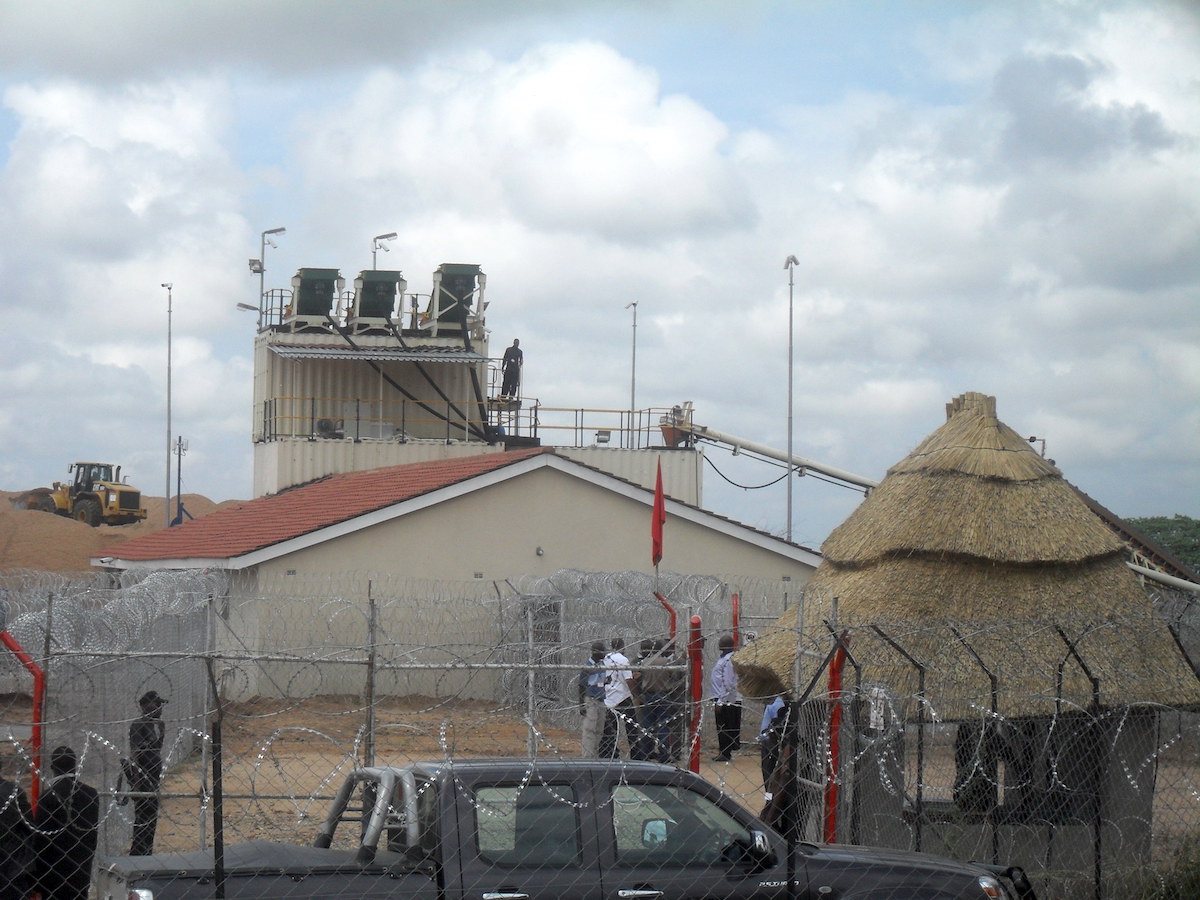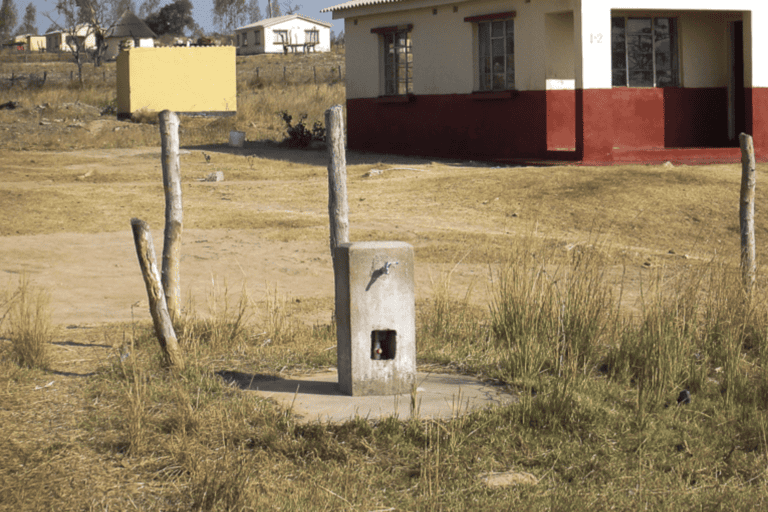- More than 14 years since the discovery of the Marange diamond fields, one of the world’s largest diamond-producing projects, relocated residents and locals living near the mines are still living in poverty.
- The government and mining companies promised homes, electricity, water, employment, social services and compensation, but residents and civil society organizations say they have still not received many of these promises since Mongabay last reported on the project in 2016.
- Rivers, which residents rely on for their livestock, vegetable plots and cleaning, are polluted and silted by artisanal miners seeking additional income and opportunities to escape poverty.
- Previously, foreign companies in Zimbabwe had to either give the majority of their shares to locals or divest money into community trusts. However, this promise has fallen short since current president, Emmerson Mnangagwa, reversed the law.
More than 14 years after being forcibly relocated from their ancestral villages to make way for mining in one of the world’s largest diamond-producing projects, residents of Arda Transau in Eastern Zimbabwe are still living in dire poverty. Across the 567-kilometer-wide (352-mile-wide) terrain of diamond fields and mines, known as Marange, that have sold at least 76 million carats of diamonds since 2010, government promises for housing and compensation have not yet been settled.
After the precious stones were discovered in the eastern Mutare district in 2006, more than 35,000 people moved to the area to dig and pan as artisanal miners or buy and sell the gems along with foreign companies. But in November 2008, the Zimbabwean government controversially took control of the mining fields and deployed the military in the Mutare and Chiadzwa diamond field areas.

During Operation Hakudzokwi, which aimed to end artisanal mining deemed illegal, over 200 people were killed when military helicopters fired on diamond panners from the air. Some people were later “buried in mass graves using bulldozers,” according to testimonies collected by human rights organizations.
By 2009, about 1,500 families were forcibly removed from the area and relocated to Arda Transau, 40 kilometers (25 miles) away in new houses built by Anjin Mining Investments, a joint venture between a Chinese firm, Anhui Foreign Economic Construction Group (AFECС), and the Zimbabwean military’s investment company, Matt Bronze.
The government and Anjin Mining Investments promised the families jobs in the mines, three-bedroom homes, electricity, running water, tarred roads, half a hectare (about 1.2 acres) of land with irrigation systems, schools, a clinic, seeds, fertilizer and food delivery every three months. The families, previously farmers and dependent on the land for their livestock, were also to receive help starting piggeries.
However, soon after they moved in, the walls in the new homes in Arda Transau began cracking.
Water supply became irregular, the irrigation systems did not materialize and the families were paid $1,000 as a relocation allowance – an amount many relocated people say is too little for the assets, homes, land and lifestyle they lost.
Twelve years later, the situation has worsened considerably, James Mupfumi, the director of the Centre for Research and Development (CRD), tells Mongabay.

“These houses were a rushed project done by the company without involving the department of public works, who inspects houses to make sure they are up to standard,” says Mupfumi. “Schools were built as promised, but they were not big enough to accommodate all the children who were moved there.”
Mongabay reached out to Anjin Mining Investments Pty (Ltd), the ministry of mines and mining development, and the Zimbabwe Consolidated Diamond Company for a comment but did not receive a response at the time of publication.
Mining still occurs in villages, such as Tarindwa, Farikai, Betera, Chiadzwa and Chirasika, where people still live, and on some private farms after it proved too difficult to relocate everyone out of the Marange area, says Mupfumi. The 26,000 people still living in the diamond mining area are now subjected to emergency provisions under the Protected Places and Areas Act.
This law allows the government to declare an area to be a “protected place” subject to emergency powers. The military sets up a presence inside the villages and demands pass cards or permits from people to prove that they are authorized to be there. The army, or anyone authorized by the government, are given powers to search and detain people and to remove them from the area. Reports of beatings and sexual abuse by some soldiers and police officers have rocked these villages.
Read more: Mongabay reported on the state of human rights abuses near the Marange diamond fields in 2016.
Switch to a poorer life
Families left behind 5 hectares (12 acres) of communal grazing land near rivers and baobab trees whose fiber they had used to make rugs to sell, and were compelled to live in small houses on dry and arid individual plots that could not sustain crops or raise livestock. Their original homes had 8 to 12 rooms and rondavels (traditional huts) to accommodate large families and relatives.
According to Newman Chiadzwa, chairperson of the Chiadzwa Community Development Trust (CCDT), the value of the homesteads villagers were forced to leave ranged from $60,000 to $200,000 depending on their size.
“The people have never been compensated to those levels,” Chiadzwa tells Mongabay.
In the villages, grandparents, parents and their married children lived together. But when the families were forced to move to Arda Transau, many young married couples were not given their own houses, and had to crowd into the tiny units with their older relatives. Some of these couples later occupied a number of houses that had been left vacant by the government-owned company, Marange Resources, but have no land tenure and are regularly threatened with eviction, Proud Nyakunu, the legal officer of the Marange-based Zimbabwe Allied and Diamond Workers Union (ZIDAWU), tells Mongabay.
“The mines have failed us. Our 10-year-old houses are so dilapidated; they look 100 years old,” she says.


According to Lloyd Sesemani, a resident of Arda Transau and a programs manager at the community-based organization, Zivai Community Empowerment Trust (ZICET), residents have no space to graze their animals.
“We are forced to live a town life, buying tomatoes, onions and grain, whereas we were used to a rural lifestyle,” says Sesemani.
The community came from a communal land where they could rear cattle and grow crops. Marange’s ground is fertile and there were a lot of ways for them to derive a livelihood, Mupfumi adds. “They were at peace in their communal land because it had forests, it had fruits, it provided them with a source of life far better than what they have now.”
Because the houses built by Anjin were never electrified relocated, people have been using firewood leading to massive deforestation in the area for firewood, Nyakunu explains.
ZIDAWU has begun a project to stop deforestation by introducing the community to wood-saving ‘Tsotso’ stoves that reduce the use of firewood by 60-70%. But without funding, the project is moving at a slow pace, Nyakunu says.
A nearby river, the Odzi River, which is used by the community as a source of water mainly for washing and small-scale gardening, is polluted by “rampant artisanal mining” nearby by locals now looking to increase their income and escape poverty. The result has been soil washing into the river and silting it up.


“Communities use river water to irrigate their vegetable plots. People used to fish along the river, but now we have families that have lost whole herds of cattle because of the polluted water that is discharged into the river,” Farai Maguwu, director of Zimbabwe’s Centre for Natural Resource Governance, tells Mongabay.
The primary source of clean water, a borehole in the village, experienced frequent power disruptions and was deemed unsafe for human consumption by health officials. In April 2020, the High Court ruled for the Zimbabwe Electricity Transmission and Distribution Company (ZETDC) to provide enough electricity to power the borehole even when Anjin Mining Investments did not pay. However, power for the borehole again went down in March this year.
“The mine plays a blame game – if you ask them about the water, [Anjin Mining Investments] shift the blame and say they’ve already paid the government for that and that they are only here for business,” Nyakunu explains.

Still awaiting compensation
Compensation has been a hotly contested issue over the years. The Indigenization and Empowerment Act of 2010 stipulated that all foreign companies with over $500,000 in assets must either sell or transfer 51% of their shares to Zimbabweans in order to give control back to local people. As part of divesting 51% to Zimbabweans, foreign-owned companies could give 10% in shares to community trusts.
The five companies who controlled the concession at the time – Marange Resources, Anjin Mining Investments, Jinan Mining, the South African private company Mbada Diamonds, and the Lebanese private company Diamond Mining Corporation – promised to transfer $10 million each into a community trust.
However, according to a Parliamentary report in 2016, Mbada Diamonds and Marange Resources were the only mines that put money into the trust, with only $400,000 deposited. Local media had reported two years earlier that some of this money had been spent on allowances to board members and traveling costs.
By 2020, relocated families told local media that they did not know where the money had gone because only a new fence had been built in the area.

In 2016, then-president Robert Mugabe ruled that foreign-owned diamond companies would have to merge with the Zimbabwe Consolidated Diamond Company, give 51% of their shares or leave the country. The companies swiftly departed Zimbabwe with Anjin Investments leaving after losing a high court case against this new ruling. But after pulling off a successful coup against Mugabe in 2017, Emmerson Mnangagwa became president seven months later and repealed the rule, bringing Anjin Investments back to Marange in 2020 and granting them a new diamond mining concession.
In the meantime, only $5 million was given to the community trust to build boreholes and new classrooms, which were eventually never completed.
However, according to the Centre for Research and Development, this money was again swallowed by corruption.
“There are 87 wards in the Mutare district who are affected by mining. Just one ward has 15 schools, so that money was almost nothing,” Mupfumi tells Mongabay. “There was also corruption and a lot of projects that were started were not completed. We can safely say the money did not make a difference.”
CRD advocates for the relocated people to be given a concession in the diamond fields suitable for safe artisanal mining, so that they can mine it collectively and share the profits. But the government currently does not agree with this concession being granted.
Currently, up to 9,000 informal miners pay bribes to State Security forces to dig in the area, says Mupfumi.
“There are illicit financial outflows orchestrated by diamond barons and state security forces. Abuses by the state securityare ongoing,” said Mupfumi. “They know the people of Marange are living in dire poverty, they know that their members are involved in abuses. It is not something that is secret.”

Banner image: Alice Gama looks at cracks that have developed on the wall of her house in Arda Transau, an area near Zimbabwe’s Chiadzwa diamond fields. Image courtesy of Linda Mujuru, GPJ Zimbabwe. Image courtesy of Chenjerai.
Related listening from Mongabay’s podcast: We bring you two stories that illustrate some of the innovative new ways conservationists are attempting to address the impacts of mining. Listen here:
FEEDBACK: Use this form to send a message to the author of this post. If you want to post a public comment, you can do that at the bottom of the page.
